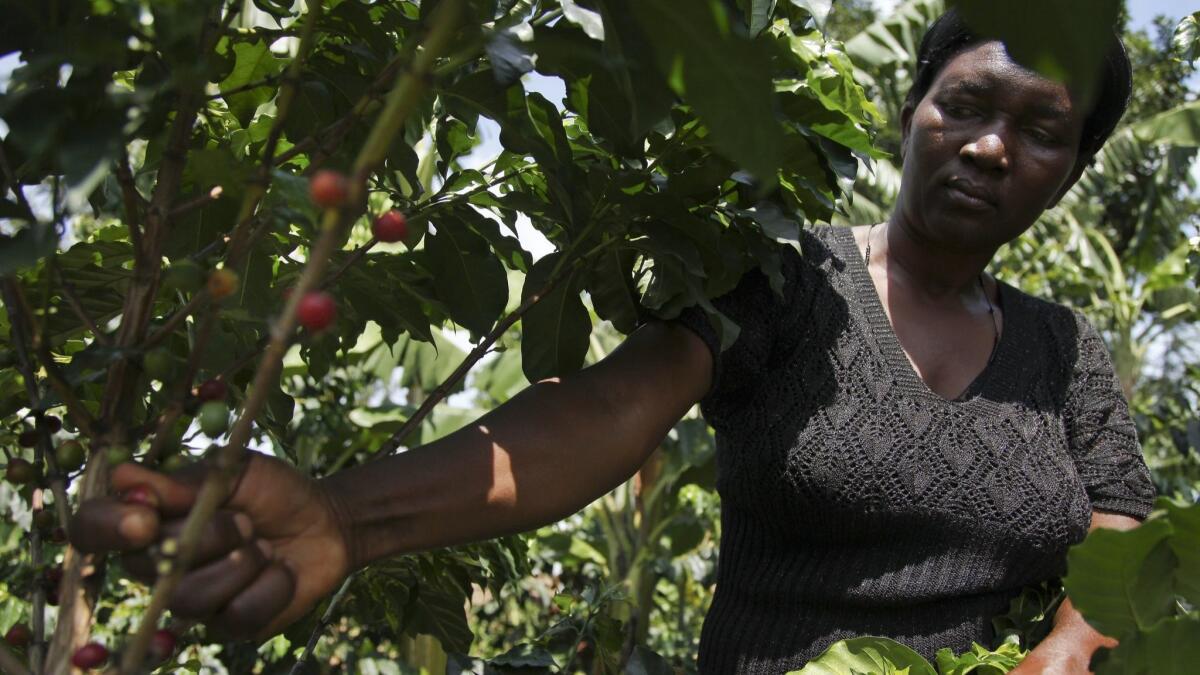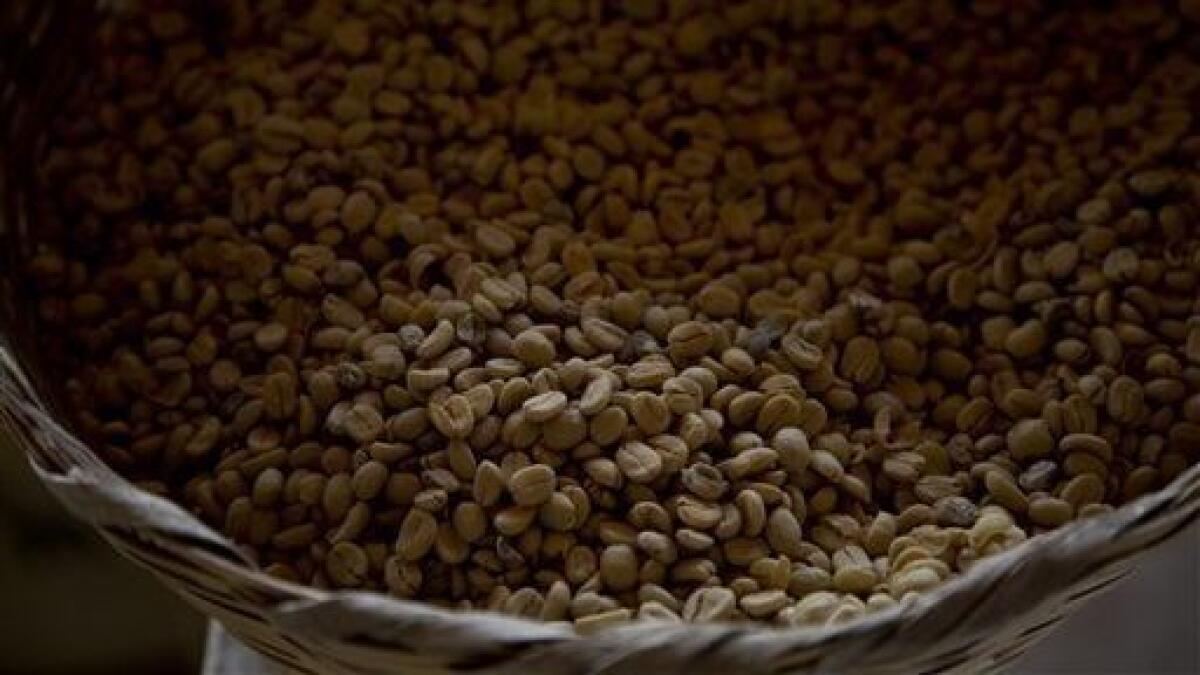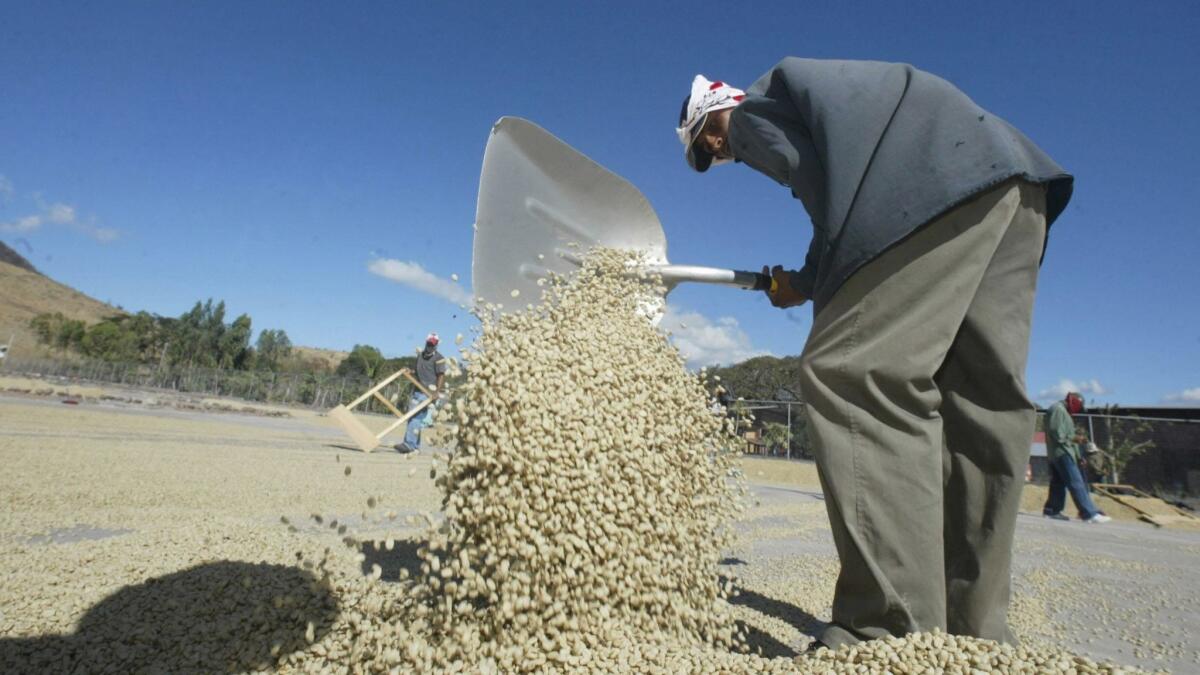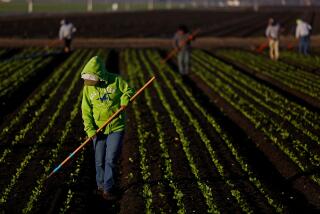The abandoned farms behind the global coffee craze

- Share via
“A lot of farms are being abandoned,” says Sonia Vásquez, an organic coffee grower on the slopes of San José in southwest Honduras. “A lot of people are migrating — many can no longer make ends meet.”
Over the last six years Vásquez, 46, has seen her crop devastated by disease — a coffee tree fungus that has ravaged parts of Latin America. Now her business has been wrecked by tumbling global prices — the value of her crop has shrunk by almost a third over the last year, falling well below break even.
Yet this should be a boom time for growers such as Vásquez in the “coffee belt,” the region over the equator between the tropics of Cancer and Capricorn. Consumers are drinking more — drip coffees, vanilla lattes, cold brews — than ever before, but Vásquez and other farmers in far-flung countries such as Peru, Papua New Guinea, Ethiopia and Ecuador are struggling. Prices of arabica beans — 60% of the market — have fallen to a near 14-year low of about 90 cents a pound on the Intercontinental Exchange.
The value of the global coffee industry has almost doubled in the last decade to $90 billion, according to Euromonitor. Despite fears that climate change could reduce supply in the medium to long term, a combination of better-than-expected harvests, more efficient producers and currency markets has conspired to keep wholesale prices low.
Both Brazil and Honduras last year reported record coffee output, while Colombia has been producing its highest levels since the 1990s. But demand has not kept pace, and there is a massive oversupply in the market.
“This has surpassed an economic crisis. People are moving away [from the farms]. They are absolutely heartbroken,” says Roberto Vélez, chief executive of the National Federation of Coffee Growers of Colombia. “Consumers don’t know what is really going on.”
Affected farmers in Guatemala and Honduras have been joining the migrant caravans to the U.S., while some in Peru and Colombia are turning to coca, the source of cocaine, traders say. Although in the short term there may be plenty of beans, the exodus from coffee growing, especially that of the higher-grade product, has fueled worries among buyers about the sustainability of future supplies.
“If the situation continues, I’m not sure where we are going to be in five years’ time,” says Matt McDonald, procurement manager at Cafédirect, a British coffee importer whose main suppliers include Peruvian co-operatives. “It’s a detrimental cycle because [the growers] cannot afford enough fertilizer, the quality reduces, the yield reduces. And it gets worse each year.”
Like many agricultural commodities, the coffee market is prone to “boom and bust” cycles in which high prices trigger the planting of more trees and better management, resulting in improved production. In the case of coffee, the cycles are accentuated as it is not an annual crop and once a tree is planted it will continue producing although yields and quality tend to drop. But when the trees first mature — up to four years after planting — the new output can weigh on prices. And those lower prices can then lead to poorer-quality beans and less output.

Some multinationals are already acting to secure supplies by providing farmers and co-operatives with technical support and tree saplings. In September, Starbucks committed $20 million to smallholder farmers in El Salvador, Guatemala, Mexico and Nicaragua.
Nestlé, the world’s largest coffee buyer, which invests about $67 million a year on technical support programs for farmers, acknowledges that the price situation is unsustainable. But it adds that addressing the issue of farmers’ income is beyond the scope of any one company, and that it is “engaging with the International Coffee Organization” to try to find some solutions.
Coffee is largely divided into robusta, the hardy lower-quality bean that is turned into instant coffee or blended into espressos to add a bitter kick, and arabica, the smooth, mild-tasting, higher-quality bean. Arabica is graded from high — the beans grown at altitude which are wet processed — to lesser quality, farmed at lower altitudes and dried in the sun.
At the root of the price problem is the increased production of low-grade arabica coffee, which is dragging the whole market lower, traders say. “There is too much commodity grade coffee,” says Stephen Hurst at Mercanta, a British trader focused on the specialty end of the market, including the artisanal drip in a café and the single-serve pod in a home machine.
This flood of beans has driven the arabica futures price lower. Coffee is bought and sold using the New York price as a reference, with higher grades traded at a premium and lower grades priced at a discount. The current benchmark has meant that even those producers who receive a premium are not able to break even. The arabica futures price has averaged about $1.20 a pound over the last three years. But over the same period the cost of producing, processing and transporting the beans has, for some growers, been more than $1.50 a pound.
This has led producers to seek a new way to price their coffee and bypass the arabica futures price as a benchmark for the industry. Some are dealing directly with growers or co-operatives to negotiate a price based on their costs and profits.
In this environment, Brazil has come to dominate the market. In addition to being the largest producer and exporter of coffee, accounting for 28% of the world’s coffee trade last year, its farmers can grow their beans at low cost, with a break-even point of less than 90 cents a pound. For many of its growers, harvesting is mechanized, with mass production allowing beans to be processed in much simpler ways compared with those in Central America and Colombia.
The country produced a record 62 million 60-kilogram bags last year, while a weak currency offered producers and exporters higher returns on beans sold overseas. Although output is predicted to take a breather this year, it could produce another large surplus in 2020. “Other producers may see falls in production,” says Carlos Mera, senior analyst at Rabobank. “But it’s unlikely to be enough to compensate for the likely increase in Brazil.”
Yet even for low-cost farmers in Brazil, current prices are starting to hit profits. José Marcos Magalhães, president of Minasul, a large coffee co-operative in Varginha in the south of Minas Gerais state that exports to 17 countries, says many of its 8,000 members are smallholders whose margins are being squeezed.
“If this price range continues, there will be unemployment,” he says.
Lúcio de Araújo Días, commercial head at Cooxupé, Brazil’s regional co-operative and its largest coffee exporter, is adamant about what is to blame for the relentless drop in prices: financial speculation. Over the last five to six years, these financial players have taken their cue from the largest producer and exporter, Brazil, and since 2017 have held record short positions, betting on a fall in prices, at a time when non-Brazilian producers are already struggling to cover their costs.
“The global financial market is selling coffee thinking it can go on forever,” Araújo Días says. “The funds are selling endlessly, every day they sell.”

Ever since the New York coffee exchange, now part of ICE, opened in the 1880s, speculators have been blamed for manipulating prices. Apart from buyers and sellers of physical coffee locking in their prices using futures, participants such as hedge funds also place bets on rising or falling coffee prices.
However, the level of speculation over the last year has led to questions from buyers and sellers, who use the benchmark to hedge their future purchases and sales, about the efficacy of the market.
“The speculators’ short positions are massive,” says Steve Pollard, coffee analyst at London brokers Marex Spectron. “But while they exaggerate the moves, they don’t determine the overall direction of the market.”
Although the growers’ stories are often used in the marketing of individual coffee brands, consumers are largely oblivious to the current plight of the farmers, assuming that the increased price they are paying for their morning brew is — at least partly — passed on to the producer.
But in an everyday $3 brew, the coffee itself accounts for about 4%, or around 12 cents — rent, labor and tax taking a much larger portion of the cost.
“The cost of coffee is really marginal” for the retailer, says Jeffrey Young, chief executive of consulting firm Allegra Strategies. “Even if your coffee beans go down 30%, the cost of cups and workers has gone up, the rent has probably gone up and everything else has gone up.”
Paying farmers a fair return for their beans has been the focus for some progressive roasters and traders in an attempt to “de-commoditize” coffee.
Ken Lander experienced the pain of the grower firsthand when he quit his legal career in the U.S. to live in San Rafael de Abangares, in northwest Costa Rica. He bought a coffee farm almost as a hobby, intending to live off his U.S. real estate sales, but he lost all his assets in the 2008 financial crisis and was forced to start selling his beans.
He quickly realized that the batch of coffee he had just sold — which was roasted in the U.S. — was generating about $30,000 in retail sales, of which he received just $600.
The 52-year-old teamed up with other growers and entrepreneur Michael Jones in 2011 to start Thrive Farmers, a coffee importing business in Atlanta that buys from about 1,000 farmers in five countries. It has a revenue-sharing model designed to give 50% to 75% of the revenue from the beans’ retail value to growers.
“How do you create a gross margin for a farmer that actually incentivizes them to want to stay in the business?” asks Lander, who is now Thrive’s chief sustainability officer but still grows his own coffee. “Our farmers have made three times more profits than their next best offer in the marketplace.”
Back in Honduras, Jairo Murillo, who grows coffee between the country’s capital, Tegucigalpa, and La Paz, needs to earn a living for his family. “We can’t survive,” says the 27-year-old who has a 1.7-acre farm. “Lots of people have left because of this. I’m thinking about leaving, or I’ll sell if I can find a buyer. There’s no other option.”
Lander says that like Thrive, many coffee companies from large to small have their own programs to help the grower. But he acknowledges that something more structural across the industry needs to be put in place.
“If we don’t, as a coffee industry, come to realize that a farmer cannot continue to grow coffee and make almost no margin or a negative margin, then we’re going to have issues,” he says. “You don’t have to be an economist to figure that out. It’s not that hard.”
© The Financial Times Limited 2019. All Rights Reserved. FT and Financial Times are trademarks of the Financial Times Ltd. Not to be redistributed, copied or modified in any way.
More to Read
Inside the business of entertainment
The Wide Shot brings you news, analysis and insights on everything from streaming wars to production — and what it all means for the future.
You may occasionally receive promotional content from the Los Angeles Times.










